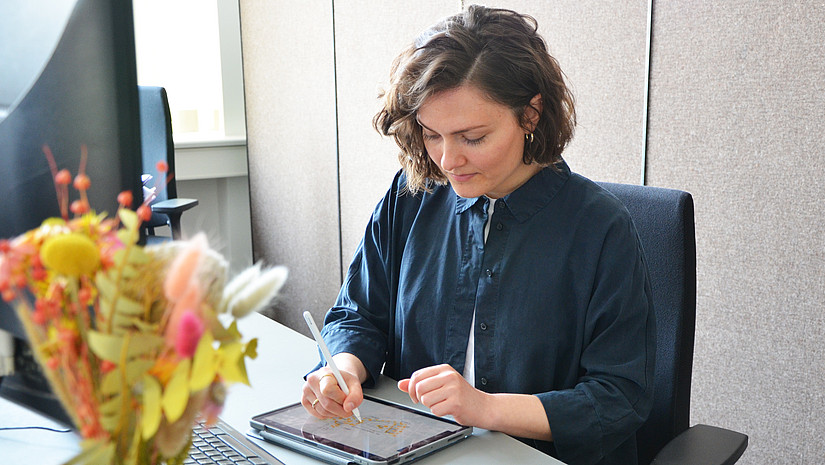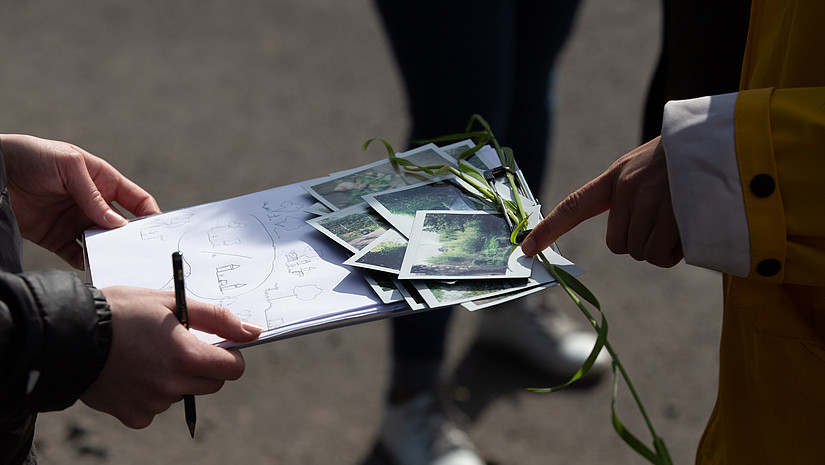Career prospects
The content on this page was translated automatically.
The career prospects after studying landscape architecture and landscape planning are wide-ranging. Graduates with a Bachelor's and Master's degree are currently in high demand on the job market.
ASL-Alumni I What does...?
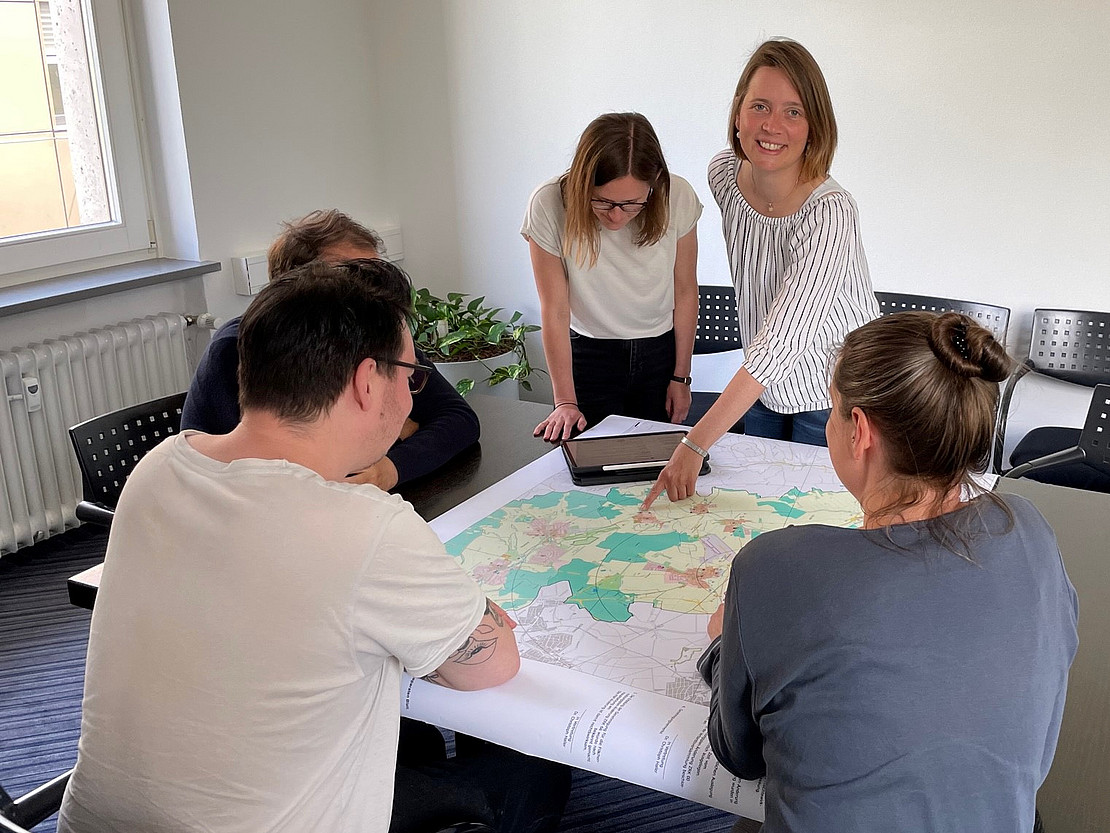 Image: Christina Grebe
Image: Christina GrebeDr. Christina Grebe
Zweckverband Raum Kassel
Christina Grebe studied landscape architecture and landscape planning at the University of Kassel, specializing in environmental management, and now works at Zweckverband Raum Kassel
Between 2002 and 2007, I completed my degree in landscape architecture and landscape planning at the University of Kassel. I deepened my studies with a subsequent master's degree in environmental management in 2009, also at the University of Kassel. After graduating, I was initially part of several research projects at the University of Kassel. There I also gained my first teaching experience through teaching assignments and finally received my doctorate in 2017.
The University of Kassel was my first choice because it promotes and challenges personal project studies. Self-selected topics that extend over a semester are the rule, not the exception - this enables a more intensive and in-depth examination of questions and problems. Added to this is the great importance of team projects. They not only promote the ability to work in a team, but also provide an initial insight into project and organizational management. These are skills that are often taught to a lesser extent in non-business-oriented degree courses, but are highly valued in professional life. The result of this team orientation: openness and curiosity for new things. Be it people, groups or topics. I appreciate these skills in my job today. Teamwork means tackling complex tasks as a whole based on a division of labor. This also includes graphic processing. A task that has accompanied me throughout my studies as well as in my current professional activity. Practical relevance, teamwork and the focus on topics over a longer period of time are, as mentioned, cornerstones of research and teaching at the University of Kassel. In the subjects of landscape architecture, landscape planning and environmental management, of course, this practice hardly ever takes place in the laboratory, but much more outdoors, in nature, in the open air, on construction sites or completed infrastructure projects. Excursions and study trips are therefore formative for my time studying in Kassel. Experience on site, whether in the Kassel area itself or throughout Europe, was therefore a constant companion. The shell of the Gotthard Base Tunnel in Switzerland, Sylt or even a small watercourse in Witzenhausen have broadened my field of vision.
For graduates of scientific disciplines that do not provide a clear job description, entering the world of work often involves a new and different focus in the field of work. For me, this means that landscape ecology, for example, is only of secondary importance. Areas such as landscape planning and communication, on the other hand, continue to play a major role in my professional practice. Keyword lateral thinking: How do public spaces or landscapes and their socially tangible components affect different groups of people, how is our landscape changing and how is our image of landscape changing as a result? These are the questions that concern me today. Fresh air corridors may serve as an example and how they have a concrete and tangible effect on the urban climate and the people in the city.
I have been working at the Zweckverband Raum Kassel, a public corporation, for two years. It has been in existence for over 45 years, currently has 22 employees and is responsible for land use and development planning for the city of Kassel and surrounding municipalities. One of my strategic tasks in the Energy and Climate department is to find answers as to how we can tackle climate change and implement the energy transition in the North Hesse region. Specifically, these answers must be formulated in a politically and socially acceptable planning context. What is needed to develop a new industrial estate, how must the energy standards be set to meet the goals of the energy transition or how can acceptance be achieved among the population? In short, as the Energy and Climate Unit, I also act as an interface to land use and landscape planning. My job is to take an overall view of the individual areas from a climate and energy perspective.
What does your day-to-day work in an interface function look like? There isn't really a typical one. I'm always moving between the different areas of administration, and I also support the content of voluntary committees. The connection to the old scientific work is a confirmation of the work
My day-to-day work today has little to do with landscape architecture or concrete project planning. It can rather be assigned to landscape planning, even if I don't actively do this planning, but it is the basis. Knowledge of the planning processes is fundamental - the requirements of the building code, for example, may sound dry. But it doesn't work without it. My job is of a conceptual nature and is suitable for people who like to talk, appreciate contact with other people and can network. And, very importantly, are interested in the environment and climate.
 Image: Anika Fleige
Image: Anika FleigeM. Sc. Anika Fleige
Bruun & Möllers GmbH & Co KG.
Anika Fleige studied landscape architecture and landscape planning with a specialization in urban planning at the University of Kassel and now works as a landscape architect at the landscape architecture firm Bruun & Möllers in Hamburg.
From 2012 to 2019, I studied landscape architecture and landscape planning at the University of Kassel, first for my Bachelor's degree and later for my Master's degree. After 2 internships in private planning offices in Hamburg and Zurich, I decided to specialize in urban planning for my Master's degree.
Looking back, in addition to the numerous excursions, the project work in small groups was a formative part of the course. Working on complex topics in a team strengthens communication skills, which come close to the way we work in a planning office today. In addition to the social aspects, the course tests students' own organizational skills, time management, resilience and stamina. Smaller and larger presentations also prepare students for professional life as a landscape architect, landscape planner or open space planner. In addition, the course teaches knowledge of and how to use (Adobe) programs such as InDesign, Photoshop and Illustrator as well as CAD programs such as Vectorworks, which planners will later use in their day-to-day work.
I have been working at the Hamburg landscape architecture firm Bruun & Möllers GmbH & Co KG since 2019. The private planning office has employed around 18 employees since 1999, who work on competitions as well as projects in service phases 1 (basic evaluation), 2 (preliminary design), 3 (design) and 4 (approval) in accordance with the Fee Structure for Architects and Engineers (HOAI). Bruun & Möllers' commissions range from public squares and urban spaces, parks and gardens, commercial and administrative buildings to educational and cultural facilities. Landscape architecture is playing an increasingly important role in the planning of the aforementioned typologies with regard to climate change. Topics such as rainwater storage, retention and evaporation, cooling, shading, planting and green roofs and façades are part of our everyday work.
Typical tasks in my day-to-day work include the preparation and revision of (preliminary) design layout plans, sections and details in CAD, communication with planning and project participants and the preparation and follow-up of project-related presentations. In addition, brochures on topics such as surfaces and coverings, equipment and furnishings, vegetation and lighting are designed. In addition to the planning and design of outdoor facilities, I am responsible for our outdoor presentation together with a colleague: As part of the PR work, I manage and update the Bruun & Möllers website as well as their Competitionline and Landscape Architecture Today presence.
I usually work on several projects at the same time. I am currently working on a project that emerged from a competition that they won: the green and play area in Albert-Schweitzer-Weg in Kiel. As this involves, among other things, a former paddling pool that is around 5 meters lower than other areas of the site, both dealing with the existing structure and height planning play a central role.
A workshop was recently held on this project with the client and playground planners. The project participants discussed different concepts and design approaches on the plan. The planners exchanged views on the special features of the site and its integration into the surroundings, the different needs of users, specific play and movement elements and the original design approach in the competition design.
I particularly enjoy designing (preliminary) design brochures for projects using Adobe InDesign. This type of design includes the development, editing and layout of graphics, illustrations, maps, pictograms, images, patterns, structures, colors and texts.
I recently worked on the furnishings and various furniture manufacturers for the Deelböge project, an office campus in the north of Hamburg. Specifically, decisions about the form, color, materiality and functionality of a chair, a table, a sunshade and a picnic bench, for example, are made in consultation and in close exchange with the client.
In my view, landscape architecture, in contrast to landscape planning, which focuses on ecology, nature conservation and rural areas, focuses on artistic design, object planning and the design of - predominantly urban - open spaces in accordance with the HOAI. Other subject areas that are closely linked to landscape architecture are transportation planning, architecture and urban planning.
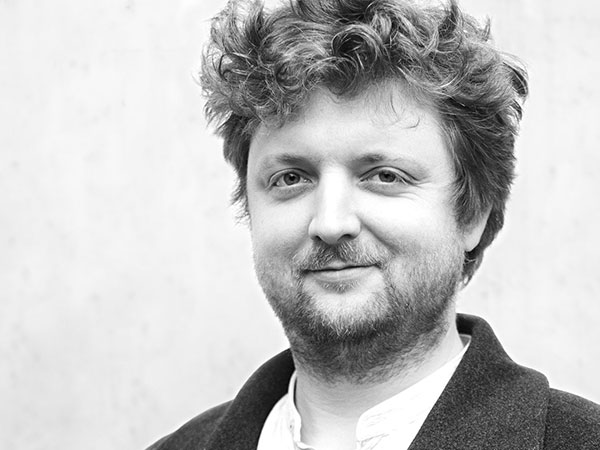 Image: Christoph Pelka
Image: Christoph PelkaM. Sc. Christoph Pelka
Head of Planungsgemeinschaft Landschaft + Freiraum
Christoph Pelka studied landscape architecture and landscape planning with a specialization in landscape architecture and open space planning at the University of Kassel from 2017 to 2021 and now heads the landscape architecture firm Planungsgemeinschaft Landschaft + Freiraum together with his partner Robert Bischer.
After graduating from high school, I first trained as a landscape gardener and then completed a bachelor's degree in landscape architecture at the Weihenstephan-Triesdorf University of Applied Sciences. I then spent some time working in a planning office in Stuttgart before completing a master's degree in landscape architecture and open space planning at the University of Kassel from 2017 to 2021.
What was particularly interesting and formative for me about the Master's degree program at the University of Kassel was the fact that a professional vision was conveyed that, in retrospect, prepared me in a special way for my everyday professional life today. This applies in particular to the high degree of interdisciplinarity, which is one of the principles of teaching at the Department of Architecture, Urban Planning and Landscape Planning. I also got to know and appreciate academic work in Kassel. Although it is used less frequently today in my object-related work in the planning office, it is still an important experience that has prepared me well for the differentiated consideration of complex relationships in everyday life. Last but not least, getting to know and interacting closely with other students, lecturers and planners was a particularly important aspect for me. At the University of Kassel, I ultimately made contact with a former lecturer and research assistant with whom I now run an office for landscape architecture.
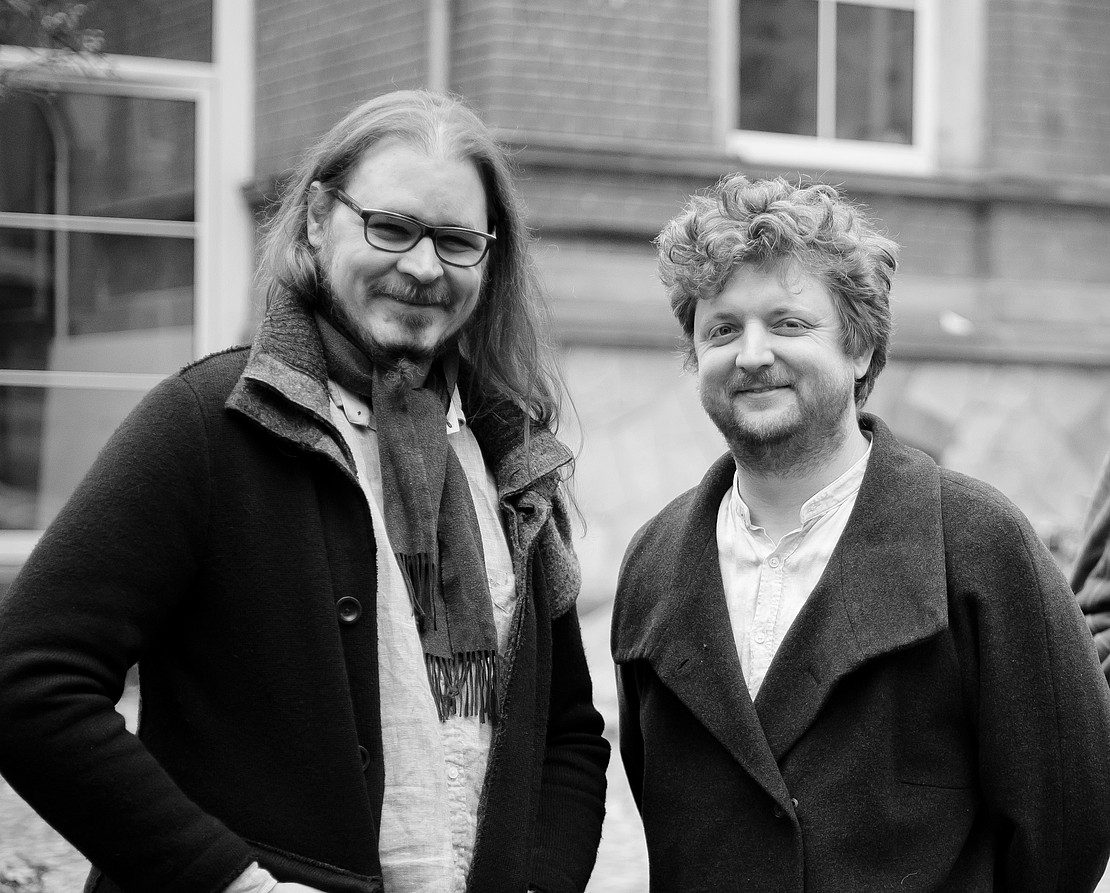 Image: Christoph Pelka
Image: Christoph PelkaOur office, Planungsgemeinschaft Landschaft + Freiraum, was founded in 1981 by the four partners Ulrike Kirchner, Anne Rogall, Andreas Schmidt-Maas and Norbert Scholz. In the course of the upcoming generational change after 40 years, I took the step into self-employment together with my office partner Robert Bischer in 2021 and took over from our predecessors in order to continue the office and practice my profession independently.
We mainly work on commissions for open space planning in public areas. Our clients are generally cities and municipalities in northern and central Hesse, parts of North Rhine-Westphalia, southern Lower Saxony and Thuringia. Our focus is on the design of inner-city open spaces such as squares and streetscapes as well as pedestrian zones, green corridors and parks. We often work in the context of historic old towns. We cover all service phases in accordance with the Fee Structure for Architects and Engineers (HOAI) and thus accompany our clients from the basic evaluation through the various design stages to the tendering and execution of the construction measures. On the one hand, my day-to-day work consists of planning work in the office, for example preparing drafts using a CAD program (computer-aided design), calculating construction costs or working on tender texts. On the other hand, we also carry out numerous external appointments, such as consultations with clients and municipal bodies, presentations to committees or citizen participation processes. A third focus of my work is the construction management of our projects, in which the construction progress is checked and managed at weekly on-site meetings. Ultimately, it is precisely this variety of different activities that makes my job so appealing.
The variety of different activities brings with it a range of skills for which my studies, training and practical work have prepared me. On the one hand, a good ability to organize complex interrelationships is a particularly important quality. The interdisciplinary project studies in Kassel were ideal for teaching me this skill. On the other hand, project work also requires a concrete technical understanding and combines this with design creativity. Last but not least, it also involves working with other people. This ranges from working within the office as part of a planning team to collaborating with external specialist planners and exchanging ideas with clients and people without a specialist background, such as affected residents.
From my point of view, the great specialty of my profession is that we landscape architects influence the reality of people's everyday lives by designing open spaces. The open spaces that we design must generate utility values for people and meet corresponding requirements. Closely linked to this, every project and its implementation also influences the development and effects of the current acute climate change. As an open space planner, in addition to a technical understanding and design creativity, you should therefore be interested above all in how people live together, what demands they have on their living environment and how these can be designed in the best possible way.
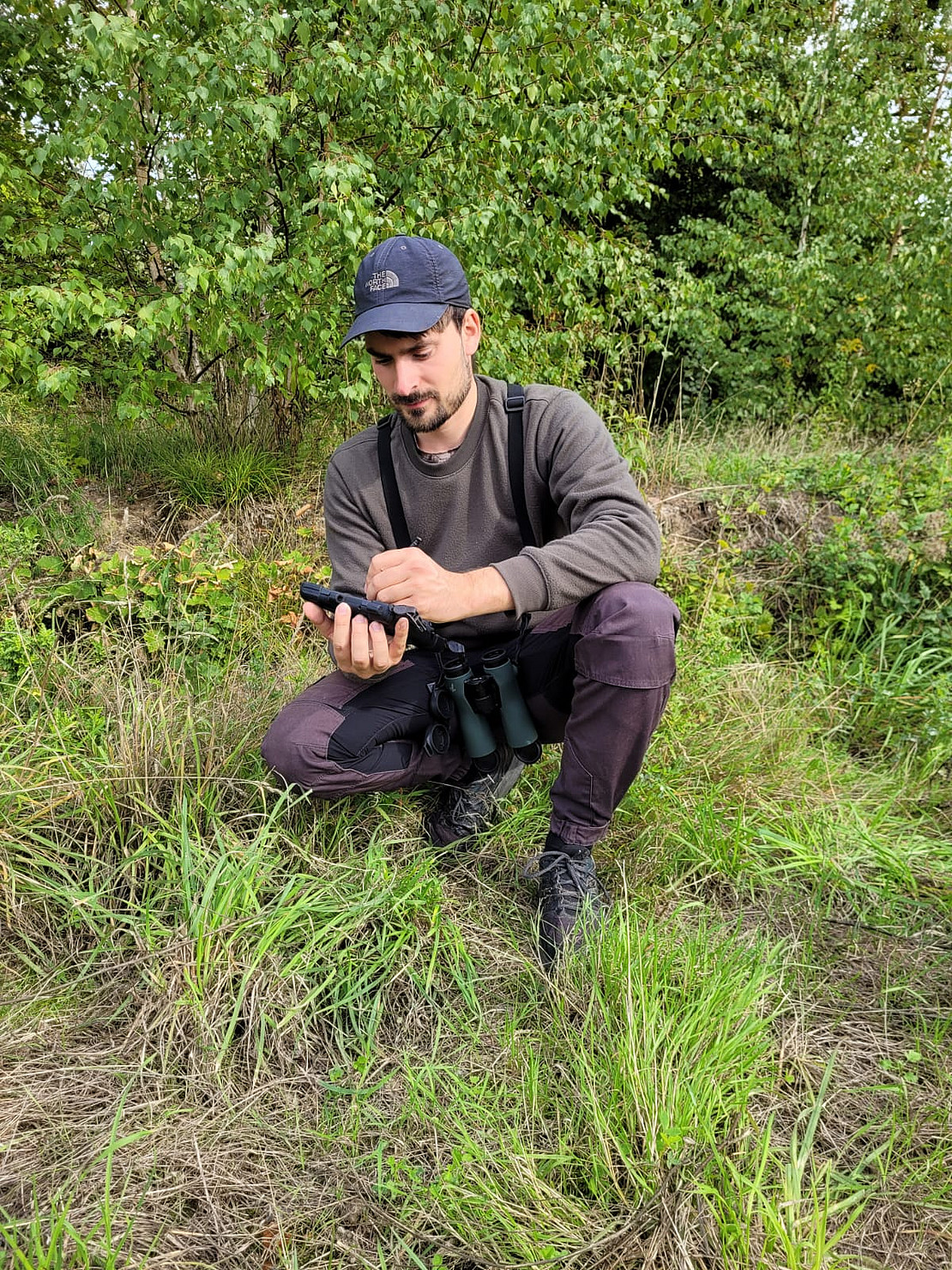 Image: Fabian Hirschauer
Image: Fabian HirschauerM. Sc. Fabian Hirschauer
Self-employed landscape planner
Fabian Hirschauer completed his Master's degree in environmental planning and landscape management at the University of Kassel and now works as a self-employed landscape planner specializing in outdoor ecology.
After leaving school, I did a voluntary ecological year at a biological station. One of my supervisors there told me that he had studied landscape planning. As I really liked the work there, I decided to study this course. In Höxter, I first studied landscape architecture for my bachelor's degree and then decided to do a master's degree in environmental planning and landscape management at the University of Kassel. I really enjoyed the course and quickly realized that I wanted to work in this field in the future. This assessment proved correct: I have been working as a freelance landscape planner specializing in outdoor ecology since April 2022.
One particularly positive aspect of my studies at the University of Kassel was the variety of topics covered in the modules. As a landscape planner, it is very important to have a comprehensive view, including of other disciplines. The chosen specialization also gave me an even deeper understanding and specialist knowledge of, for example, interrelationships in the landscape, which made it easier for me to "read" the landscape.
Overall, my studies were very project-oriented and consisted less of lectures, which I find very important. Working on planning tasks independently, but also in groups, gave me confidence in dealing with planning situations, which I benefit from today. On the one hand, the project reports at the time were similar in structure to the expert reports that I now write as a freelance landscape planner. On the other hand, I developed confidence in dealing and communicating with other people, which is very important in the working world. My studies prepared me very well for my professional life. It's a good feeling to be able to apply the knowledge and skills I've gained through my studies in practice and earn a living with them.
I also really enjoyed the extensive range of excursions on offer. Trips to Romania and other places and countries not only provided a lot of specialist knowledge, but also a lot of fun with lecturers and fellow students.
Student life in the city of Kassel was a great experience. While many friends went home at the weekend while studying in the small town of Höxter, it was different in Kassel. I think that students are more likely to move their lives here than they were in Höxter. There is simply "more life" in a larger city, and that also applies to the campus. I spent many nice evenings there with my friends.
In my job, I am mainly involved in practical rather than purely conceptual landscape planning. This means that my work largely consists of field work, including a lot of breeding, resting and migratory bird mapping in the course of wind energy expansion. In my subsequent "office time" at my desk, I also work on various expert reports on the optimization of nature conservation areas. Another focus of my work is a teaching assignment at the University of Kassel.
A typical working day in spring and early summer, i.e. during the main breeding bird survey period, starts with getting up very early. At best, the mapping starts before sunrise. Whereas in the past, mapping was done with a pen and printed map, nowadays it is done digitally with a tablet and recording apps. Fortunately, digitalization has also found its way into practical field work.
I particularly enjoy nature conservation reports, for which I work through all the essential planning steps: from mapping valuable species and defining target species, to formulating concepts and guiding principles, to planning specific measures. What I find particularly appealing about this work is that I can turn my own ideas and visions into reality and thus make a direct contribution to nature and species conservation. I have the feeling that this opportunity is often denied to me in my professional life and that good ideas and plans can come to nothing. It gives me great pleasure to visit my own plans after a few years and find animal and plant species that would not have found a habitat there without my own work. That is the greatest motivation for my work.
My line of work is recommended for people who like being outdoors. I think everyone likes that, but whether you can really cope with getting up early and going out, even if the sun isn't shining, is perhaps another question. For me, it also involves a lot of independent work and organization, especially as a self-employed person. Nevertheless, you should like working in a team, because communication and sharing experiences are always part of it.
For me, ecological topics and knowledge of the requirements and characteristics of species are particularly important, whereas technical issues play a subordinate role. My work is not artistically creative like landscape architecture, but creativity is still part of my work. In the context of landscape and nature conservation planning, there are often a variety of ways to formulate objectives and develop concepts and measures. Of course, nothing should be "plucked out of the air", but must always be professionally justified. Dealing with existing protected assets, conflicts of interest and stakeholders therefore requires both scientifically sound and creative thinking.
Prospective landscape planners have excellent career prospects. Above all, people with knowledge of species are in demand. So if you can imagine spending a lot of time with wild bees, birds, amphibians and the like, I can only recommend following a career path similar to mine.
